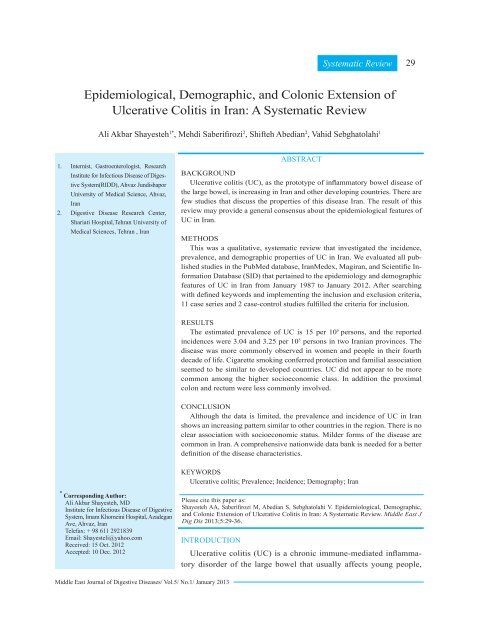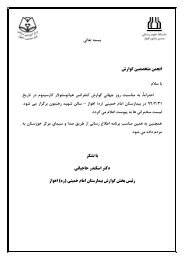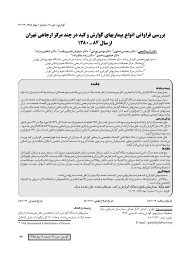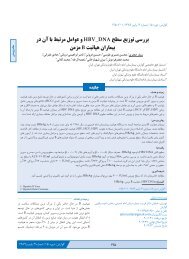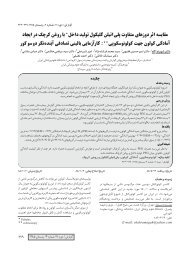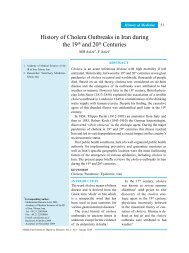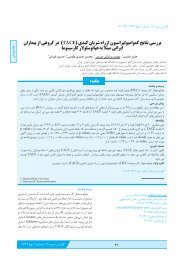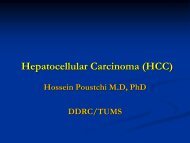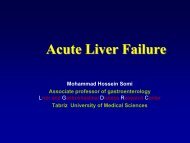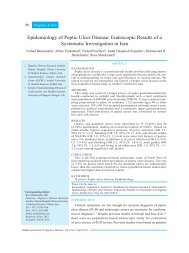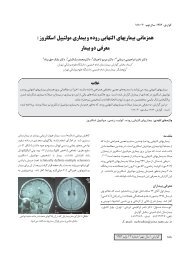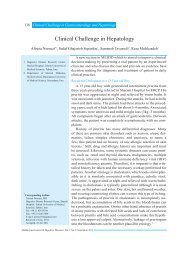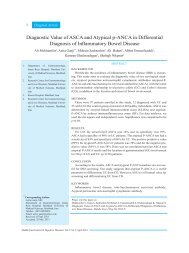A Systematic Review - IAGH
A Systematic Review - IAGH
A Systematic Review - IAGH
Create successful ePaper yourself
Turn your PDF publications into a flip-book with our unique Google optimized e-Paper software.
<strong>Systematic</strong> <strong>Review</strong><br />
29<br />
Epidemiological, Demographic, and Colonic Extension of<br />
Ulcerative Colitis in Iran: A <strong>Systematic</strong> <strong>Review</strong><br />
Ali Akbar Shayesteh 1* , Mehdi Saberifirozi 2 , Shifteh Abedian 2 , Vahid Sebghatolahi 1<br />
1. Internist, Gastroenterologist, Research<br />
Institute for Infectious Disease of Digestive<br />
System(RIDD), Ahvaz Jundishapor<br />
University of Medical Science, Ahvaz,<br />
Iran<br />
2. Digestive Disease Research Center,<br />
Shariati Hospital,Tehran University of<br />
Medical Sciences, Tehran , Iran<br />
ABSTRACT<br />
BACKGROUND<br />
Ulcerative colitis (UC), as the prototype of inflammatory bowel disease of<br />
the large bowel, is increasing in Iran and other developing countries. There are<br />
few studies that discuss the properties of this disease Iran. The result of this<br />
review may provide a general consensus about the epidemiological features of<br />
UC in Iran.<br />
METHODS<br />
This was a qualitative, systematic review that investigated the incidence,<br />
prevalence, and demographic properties of UC in Iran. We evaluated all published<br />
studies in the PubMed database, IranMedex, Magiran, and Scientific Information<br />
Database (SID) that pertained to the epidemiology and demographic<br />
features of UC in Iran from January 1987 to January 2012. After searching<br />
with defined keywords and implementing the inclusion and exclusion criteria,<br />
11 case series and 2 case-control studies fulfilled the criteria for inclusion.<br />
RESULTS<br />
The estimated prevalence of UC is 15 per 10 5 persons, and the reported<br />
incidences were 3.04 and 3.25 per 10 5 persons in two Iranian provinces. The<br />
disease was more commonly observed in women and people in their fourth<br />
decade of life. Cigarette smoking conferred protection and familial association<br />
seemed to be similar to developed countries. UC did not appear to be more<br />
common among the higher socioeconomic class. In addition the proximal<br />
colon and rectum were less commonly involved.<br />
CONCLUSION<br />
Although the data is limited, the prevalence and incidence of UC in Iran<br />
shows an increasing pattern similar to other countries in the region. There is no<br />
clear association with socioeconomic status. Milder forms of the disease are<br />
common in Iran. A comprehensive nationwide data bank is needed for a better<br />
definition of the disease characteristics.<br />
KEYWORDS<br />
Ulcerative colitis; Prevalence; Incidence; Demography; Iran<br />
* Corresponding Author:<br />
Ali Akbar Shayesteh, MD<br />
Institute for Infectious Disease of Digestive<br />
System, Imam Khomeini Hospital, Azadegan<br />
Ave, Ahvaz, Iran<br />
Telefax: + 98 611 2921839<br />
Email: Shayesteli@yahoo.com<br />
Received: 15 Oct. 2012<br />
Accepted: 10 Dec. 2012<br />
Please cite this paper as:<br />
Shayesteh AA, Saberifirozi M, Abedian S, Sebghatolahi V. Epidemiological, Demographic,<br />
and Colonic Extension of Ulcerative Colitis in Iran: A <strong>Systematic</strong> <strong>Review</strong>. Middle East J<br />
Dig Dis 2013;5:29-36.<br />
INTRODUCTION<br />
Ulcerative colitis (UC) is a chronic immune-mediated inflammatory<br />
disorder of the large bowel that usually affects young people,<br />
Middle East Journal of Digestive Diseases/ Vol.5/ No.1/ January 2013
30 Ulcerative Colitis in Iran<br />
greatly impacting their health and activity levels. 1,2<br />
The pathogenesis of this disease is unknown, however<br />
inappropriate interactions between genetic,<br />
immunological, and environmental factors have<br />
an important effect. Affected patients may present<br />
with chronic blood and passage of mucous in the<br />
stool in mild forms of the disease to severe bloody<br />
diarrhea, abdominal distension, fever, weight loss,<br />
and toxic megacolon in severe cases. 3 Unpredictable<br />
remissions and exacerbations are typical and<br />
extraintestinal involvement is common in affected<br />
patients. UC is more common in developed countries,<br />
especially in northern Europe and America, 4<br />
traditionally it has rarely been seen in developing<br />
countries. A gradual increase in the incidence and<br />
prevalence of this disease in developing countries<br />
has coincided with an improvement in health, sanitation,<br />
and a more Western life style in nations<br />
such as India, 5 Japan, 6-8 and South Korea. 9 The<br />
Iranian people have rapidly improved their health<br />
status over the previous three decades, which coincides<br />
with reports of an increasing burden of<br />
this disease. However, due to wide geographical<br />
and ethnic variation, the pattern of epidemiological<br />
characteristics and risk factors are not clearly<br />
defined. The purpose of this study is to evaluate<br />
and interpret all published evidence that relate to<br />
the epidemiological, clinical presentation, and risk<br />
factors of UC in Iran during the last 25 years.<br />
MATERIALS AND METHODS<br />
This research was a qualitative systematic review<br />
on the epidemiology and risk factors of UC in Iran.<br />
All English and Persian language articles published<br />
from January 1987 to January 2012 in PubMed,<br />
IranMedex, Magiran, and Scientific Information<br />
Database (SID) were surveyed through a comprehensive<br />
search. UC studies were determined using<br />
the following terms:<br />
(“Ulcerative colitis”[Text Word]) OR (“Colitis,<br />
Ulcerative” [Text Word]) OR (“Inflammatory Bowel<br />
Diseases”[Text Word]) OR (“Mortality”[Text<br />
Word]) OR (ʺ incidenceʺ [Text Word]) OR (“Age<br />
of onset”[Text Word]) OR (ʺPrevalenceʺ [Text<br />
word]) OR (“Mortality risk ratio”[Text word])<br />
OR(“Mortality relative risk”[text word] OR<br />
(ʺrecurrenceʺ[Text Word]) OR (“Mortality RR”<br />
[Text Word]) OR(“Remission, Spontaneous”[Text<br />
Word]) OR (“natural history”[Text word]) OR<br />
(“Mortality”[MesH]) OR (“Incidence”[MesH]) OR<br />
(“Prevalence”[MesH]) OR (“Recurrence”[MesH])<br />
OR(“Remission, Spontaneous”[MesH]) OR<br />
(“Colitis, Ulcerative”[MesH]) OR (“Inflammatory<br />
Bowel Diseases”[MesH]) OR (“Natural<br />
History”[MesH]) OR (“ disease duration”[Text<br />
Word]) OR (“Incidence”[MesH]) OR (ʺincidenceʺ<br />
[Text Word]) OR (ʺPrevalenceʺ [Text Word]) OR<br />
(“Prevalence”[MesH]) (ʺduration ʺ [Text Word])<br />
AND (ʺIranʺ [Text Word]) in PubMed. The search<br />
study was limited to adult humans. For Persian language<br />
articles, the search terms included Persian<br />
translations of UC and epidemiology as suggested<br />
by the Persian Language and Culture Academy.<br />
Inclusion criteria<br />
We collected cross-sectional and case series<br />
studies in which the UC diagnosis was verified on<br />
the basis of clinical, endoscopic, radiological, and<br />
histological criteria by using the Lennard-Jones<br />
method. 10 Two reviewers reviewed the articles for<br />
eligibility according to the above criteria. In cases<br />
of disagreement between the reviewers, inclusion<br />
of the article in question was resolved by consensus.<br />
Data extraction<br />
All data extracted by the two reviewers were<br />
entered on to a spreadsheet (Microsoft Excel XP<br />
Professional Edition; Microsoft Corp., Redmond,<br />
Washington). Discrepancies were resolved as previously<br />
mentioned.<br />
Quality assessment<br />
After data base searches, the quality of the studies<br />
was evaluated by a scoring system created according<br />
to predefined criteria (Table 1). This scoring<br />
system consisted of four variables: 1) clearance<br />
in general objects of the study, 2) sampling, 3) rel-<br />
Middle East Journal of Digestive Diseases/ Vol.5/ No.1/ January 2013
Shayesteh et al.<br />
31<br />
Table 1: Assessment for article quality.<br />
<strong>Review</strong>er : 1 □ 2 □<br />
Articles<br />
1st step: Decision after reading the title and abstract. 1 2 3 4 5<br />
Reject □<br />
Accept □<br />
2nd Step: Complete the following when the entire article is read.<br />
Research question<br />
Has the research aim been explained sufficiently and<br />
clearly<br />
Has the population study been clearly defined<br />
Have the outcomes been considered clearly<br />
Are the time and location boundaries explained<br />
Sampling<br />
Has the sample size been appropriately defined<br />
Was random sampling performed<br />
Do selected patient characteristics correspond to the<br />
defined population<br />
Measurements<br />
Were valid and reliable tools used<br />
Were identical tools used<br />
Did a trained interviewer gather data<br />
Analysis<br />
Was subgroup analysis performed<br />
Was there a suitable analysis method<br />
Total score<br />
Final decision<br />
Reject □<br />
Accept □<br />
Reject □<br />
Accept □<br />
Reject □<br />
Accept □<br />
If an article has a considered character, it will be assigned 1 point.<br />
If an article has total score of more than 6, it will be accepted and entered in the next step.<br />
Reject □<br />
Accept □<br />
Reject □<br />
Accept □<br />
Reject □<br />
Accept □<br />
Reject □<br />
Accept □<br />
Reject □<br />
Accept □<br />
Reject □<br />
Accept □<br />
evant scaling, and 4) data analysis. Two reviewers<br />
independently assessed the articles according to<br />
this system. If an article had more than 6 out of 12<br />
points, it was entered into the study and the full text<br />
of the article was evaluated. We chose articles that<br />
evaluated the epidemiology, demographic character,<br />
and risk factors of UC with appropriate methodology.<br />
RESULTS<br />
The search identified 407 potentially relevant<br />
citations (Figure 1, Table 2). From these, we identified<br />
11 case series studies that comprised 1882<br />
individuals diagnosed with UC and 2 case-control<br />
studies. There was 80% agreement between the two<br />
reviewers (A.A.S. and M.S.F.) in assessing study<br />
eligibility. Fani, 11 in a study conducted in Arak,<br />
Iran estimated the incidence of UC to be 3.04 per<br />
10 5 individuals and Masoodi et al. 12 in Hormozgan<br />
Province, Iran estimated the incidence of UC to be<br />
3.25 per 10 5 individuals. The prevalence of UC in<br />
Arak in 2000 was estimated by Fani as 15.5 in 10 5 .<br />
Patients’ demographic characteristics are shown<br />
in Table 3. There were 1039 female patients (F/M:<br />
1.23). Patients’ mean age at the time of diagnosis<br />
was approximately 34 years. In all studies, with the<br />
exception of one study, patients’ mean ages were<br />
in the fourth decade of life One of the studies revealed<br />
a second peak.<br />
Smoking was common in 2.3% to 15.5% of patients<br />
in seven studies. In the case-control studies,<br />
there was an inverse relation between smoking and<br />
the presence of UC (p ≤ 0.002, OR: 0.31921, 13 and<br />
p
32<br />
Ulcerative Colitis in Iran<br />
Fig. 1: Flow diagram for assessing studies identified in the systematic review.<br />
Table 2: Number of related articles in various indexes.<br />
Articles PubMed (n) Iran Medex (n) Magiran (n) SID* (n)<br />
Primary search 152 97 86 72<br />
<strong>Review</strong> of title<br />
and abstract<br />
<strong>Review</strong> of full<br />
text<br />
There were overlaps between data base sources<br />
*SID: Scientific Information Database<br />
13 13 5 3<br />
5 7 4 2<br />
Table 3: Demographic characteristics and risk factors of UC in 11 Iranian studies.<br />
Case (n)<br />
F/M ratio<br />
Dariani 15 200 1.22<br />
Aghazade 16 401 1.25<br />
Fani 11 97 1.1<br />
Zahedi 17 85 1.25<br />
Keshavarz 18 85 0.8<br />
Age/years<br />
(SD year)<br />
27.4<br />
(10.4)<br />
31.9<br />
(11.8)<br />
39.3<br />
(15.4)<br />
Smoking<br />
(%)<br />
Urban<br />
(%)<br />
Higher<br />
education<br />
Familial<br />
(%)<br />
11 NA† 80 28<br />
1<br />
5.5<br />
33.3<br />
(13.2) 5.9<br />
34.1<br />
(16.0)<br />
95.9 66 13.8<br />
NA NA NA NA<br />
NA NA NA<br />
NA NA NA NA<br />
Fakheri 19 265 1.15 34.5 (14)<br />
2.3<br />
77.6 25.3 3.4<br />
Vahedi 20 293 1.4 37.2(13.7)<br />
Masjedi 21 166 1.3<br />
Yazdanbod 22 105 1.38<br />
Semnani 23 104 1.2<br />
13.3<br />
38.6<br />
(17.4) 13<br />
33.5<br />
(13.1) 10.4<br />
37.8<br />
(15.1)<br />
90 46.4 9.6<br />
NA NA 9<br />
83.8 NA NA<br />
15 34.6 83.3 NA<br />
Masoodi 12 79 1.25 32.8 (16)<br />
†Not available<br />
NA<br />
NA 12.4 NA<br />
Middle East Journal of Digestive Diseases/ Vol.5/ No.1/ January 2013
Shayesteh et al.<br />
33<br />
companied by appearance of disease. 15 In addition,<br />
the extension of UC wasn’t affected by cigarette<br />
smoking. 13<br />
City dwellers, which might have a higher socioeconomic<br />
status compared with villagers, comprised<br />
34.5%-94% of UC patients. Another indicator<br />
of higher socioeconomic status was higher<br />
education level which was considered in five studies<br />
and varied from 12.4%-80% of the studied populations<br />
(Table 3).<br />
The duration of symptoms at the time of diagnosis<br />
was assessed in nine studies with a mean of<br />
8-13.9 months and appeared to have decreased in<br />
recently published articles (Table 4). Disease extension<br />
was assessed in all studies. In the most common<br />
forms, UC seemed to be limited to the left<br />
side of the colon (Table 4). Proctitis was the second<br />
most common form of UC. In the least common<br />
form, UC extended beyond the splenic flexure.<br />
Familial propensity to UC was evaluated in five<br />
studies and had an intense discrepancy that ranged<br />
from 3.4%-28%. Overall, approximately 10%-15%<br />
represented familial aggregation in other studies<br />
(Table 4). Four studies evaluated the consumption<br />
of oral contraceptive pills (OCP), which comprised<br />
approximately 6.5%-32% of UC cases (Table 5).<br />
These studies failed to show any relation between<br />
the duration of contraceptive use on the extension<br />
of the colonic involvement.<br />
Over 83% of patients in three studies were breast<br />
fed during infancy, but the duration of breast feeding<br />
and the use of formula milk or whole milk in nonbreast<br />
fed individuals was not determined (Table 5).<br />
Case control studies also revealed that breast-feeding<br />
did not prevent the development of UC.<br />
DISCUSSION<br />
The first report of inflammatory bowel disease<br />
(IBD) from Iran presented UC as a rare disorder. 24<br />
An estimation of the incidence and prevalence of<br />
UC in Iran has limitations. First, there is no national<br />
data bank for registration of all patients. Second,<br />
there are only a few studies that evaluate the prevalence<br />
or incidence of this disease. It seems that the<br />
Table 4: Colonic extension and duration of symptoms in Iranian UC<br />
cases.<br />
Proctitis<br />
(%)<br />
Left- sided<br />
colitis (%)<br />
Extensive<br />
colitis<br />
(%)<br />
Duration<br />
(months)<br />
Dariani 15 32 52 16 11.9<br />
Aghazade 16 51.9 30 18.1 13.9<br />
Fani 11 26.8 47.5 25.7 *NA<br />
Zahedi 17 8.3 51.5 39.8 8.1<br />
Keshavarz 18 23.5 57 8.23 NA<br />
Fakheri 19 36.2 48.3 15.5 9.74<br />
Vahedi 20 51 32 17 8<br />
Masjedi 21 20.4 60 17.4 12<br />
Yazdanbod 22 36.2 55 3.8 9<br />
Semnani 23 32 52 16 11.9<br />
Masoodi 12 51.9 30 18.1 13.9<br />
*NA: Not available<br />
Table 5: Risk factors for UC in Iranian studies.<br />
OCP (%) Breast feeding (%)<br />
Aghazade 16 32 85.5<br />
Zahedi 17 19.1 83.5<br />
Fakheri 19 27 87.7<br />
Masoodi 12 6.5 NA*<br />
*Not available<br />
OCP: Oral contraceptive pill<br />
absence of systematic registration and the limited<br />
access to medical care and diagnostic tools have a<br />
significant role in the inaccuracy of the present epidemiological<br />
data.<br />
There were two reports on UC incidence in Iran,<br />
one by Fani conducted in Arak (Central Iran, in a<br />
cold region) 11 and the other conducted in Hormozgan<br />
Province (Southern Iran, in a warm region) by<br />
Masoodi et al. 12 .Fani reported an incidence of 3.04<br />
out of 10 5 individuals and Masoodi et al. reported an<br />
incidence of 3.25 out of 10 5 individuals. However,<br />
this might be an underestimation of the incidence.<br />
Due to the low case fatality and mortality rate for<br />
UC, the estimated prevalence in the Fani study has<br />
increased in recent years. These data are similar to<br />
the reports on the incidence of UC in neighboring<br />
Middle Eastern countries, such as Turkey (4.4 in<br />
10 5 ) 25 and Kuwait (2.8 in 10 5 ). 26<br />
Middle East Journal of Digestive Diseases/ Vol.5/ No.1/ January 2013
34<br />
Ulcerative Colitis in Iran<br />
Sood et al. 5 in a population based study from<br />
Punjab, India have reported the highest incidence<br />
(6.02 in 10 5 ) for UC in Asia. This is much higher<br />
than both Japan 6 and Korea. 9 Industrialization,<br />
which is discussed as a coincident factor, began in<br />
Japan, South Korea and Iran prior to its onset in<br />
India. These differences should be evaluated more<br />
precisely before reaching any definite conclusion,<br />
but rapidity and the time of industrialization startup<br />
which differs in these countries may be a cause<br />
for the discrepancies. 27 Genetic background in association<br />
with environmental changes (dietary, psychosocial,<br />
and immunological) in the Indian immigrant<br />
community in the UK and Canada increased<br />
the incidence of UC more than residents India. 28<br />
It seemed that the absence of systematic national<br />
registration and limited access to medical care and<br />
diagnostic tools in some areas, had a significant role<br />
in the inaccuracy of epidemiological data from Iran<br />
and India.<br />
There were several differences in the clinical<br />
characteristics of ulcerative colitis compared<br />
to the western population. There was an overall<br />
female predominance (F/M = 1.23:1), that is different<br />
from westeren population,which had equal<br />
or slightly female predominance(Table 3). 4,29 This<br />
finding is close to the M/F ratio (0.78) in a pooled<br />
analysis of UC in Iran by Derakhshan et al. 30 Female<br />
predominance has also been observed in other<br />
Middle Eastern countries and in some parts of the<br />
Pacific as well. 31 This figure is not entirely related<br />
to earlier referrals to physicians or more disturbing<br />
symptoms in women; it may be related to ethnic<br />
and other environmental factors. In Iran, 6.55-32%<br />
of females with UC were oral contraceptive users,<br />
that isn’t an acceptable description for this finding.<br />
In spite of that Turkey, 25 Saudi Arabia, 32 and India 5<br />
have a male predominance of UC. This figure is not<br />
entirely related to earlier referrals to physicians or<br />
more disturbing symptoms in women; it may be related<br />
to ethnic and other environmental factors. In<br />
Iran, 6.55-32% of females with UC were oral contraceptive<br />
users, that isn’t an acceptable description<br />
for this finding.<br />
The mean age of the patients at first presentation<br />
is approximately 34 years. However, the mean age<br />
of patients at time of diagnosis in Western countries<br />
is in the third decade of life, with another peak reported<br />
in the fifth to seventh decades of life, which<br />
has not been reported in published data from Iran.<br />
This has also been observed in the Indian subcontinents.<br />
A second peak has been reported in the Turkish<br />
population, 25 as seen with Western countries.<br />
Cigarette smoking is a known protective factor<br />
in UC and observed in 2.3% to 15.5% of patients,<br />
15-17,19-23 Case control studies have shown<br />
this inverse relation 13,14 and cessation of cigarette<br />
smoking has induced UC. These studies have failed<br />
to show that extension of UC can be affected by<br />
smoking.<br />
The family history of UC was seen in a diverse<br />
range (3.4% to 28%) of affected patients. 16,19-21 This<br />
difference might be due to inappropriate case selection<br />
in these studies. Overall familial association<br />
was seen in over 10% of patients, which approximated<br />
the previously pooled analysis by Darakhshan<br />
et al. 30 and was similar to Western countries.<br />
Familial association was noted in about 2.2% of<br />
UC subjects in Sri Lanka, 31 but this issue was observed<br />
in about 10%-20% of Saudi Arabian subjects.<br />
32 Considering the interfamily marriage in our<br />
country, as with Saudi Arabia and particularly in<br />
some ethnic areas, a familial association might be<br />
increased.<br />
There was more UC among the higher socioeconomic<br />
classes in Europe and the US. 29 In Iran,<br />
the higher socioeconomic status might be defined<br />
by higher education and residence in urban areas.<br />
Higher education varied in Iranian UC subjects,<br />
from 12.4%-83% (Table 3). This variation might be<br />
explained by differences in education levels where<br />
the studies were performed. A case control study<br />
did not report that more educated individuals were<br />
likely to have UC. 13<br />
Another index, urban residence, varied from<br />
34.6% to 95.9% in Iranian studies (Table 3). These<br />
differences in part, might be related to the study<br />
population and availability of medical facility in<br />
cities. In addition, a case-control study did not<br />
show any relation to birthplace (villages or cities)<br />
Middle East Journal of Digestive Diseases/ Vol.5/ No.1/ January 2013
Shayesteh et al.<br />
35<br />
and presence of UC. 13<br />
Several studies did not show an inverse association<br />
between UC and breast feeding, but increased<br />
episodes of diarrhea in infancy, which were more<br />
frequent in non-breast feed infants seemed to be associated<br />
with UC. More than 83% of UC patients<br />
were breast fed as infants in three of these studies<br />
(Table 5). There was no report regarding the duration<br />
of breast feeding in breast fed infants and type<br />
of formula in non-breast fed infants. Because the<br />
proportion of nursing mothers in the native population<br />
has not been clearly defined, a more appropriate<br />
conclusion regarding breast milk consumption<br />
could not be substantiated. Rahimi et al. have revealed<br />
that breast milk could not prevent subsequent<br />
UC. 13 Proximal involvement of the colon, such as<br />
cecum and transverse colon, have been reported in<br />
3.4%-25% of studies (Table 4), which might denote<br />
prediction of a less severe course for UC among<br />
Iranian patients. Fulminant disease is mentioned in<br />
one study and was seen in 0.37%, 19 which might<br />
be an indicator of lower frequency of severe disease.<br />
The interval between symptom onset until diagnosis<br />
of UC was greater than eight months, but<br />
appears to have decreased in more recent studies<br />
(Table 3). This earlier diagnosis might be related<br />
to increased awareness of people and physicians,<br />
improved diagnostic facilities and more access to<br />
gastroenterologists.<br />
There are few well-designed reports regarding<br />
epidemiological data of UC in Iran. The available<br />
data shows the incidence of UC between 3.04 and<br />
3.25 per 105 individuals, which is in the range of<br />
other Middle East countries. There is a trend for<br />
increasing occurrence of UC, as with other developing<br />
countries. The F/M ratio is 1.23 and most patients<br />
present in the fourth decade of life. Although<br />
ex-smokers are prone to disease presentation, the<br />
extent of disease is not affected by cigarette smoking.<br />
Most patients have a mild form of UC and leftsided<br />
colitis. We propose the establishment of a<br />
nationwide comprehensive data bank for to more<br />
aptly define UC disease characteristics.<br />
ACKNOWLEDGMENT<br />
The authors thank Professor Reza Malekzadeh for his<br />
scientific support. The article is supported by Research<br />
institute for Infectious Disease of Digestive System<br />
(RIDD) in Ahvaz Jundishapour University of Medical<br />
Science (AJUMS) and Digestive Disease Research Center<br />
(DDRC) in Tehran University of Medical Science<br />
(TUMS).<br />
CONFLICT OF INTEREST<br />
The authors declare no conflict of interest related to<br />
this work.<br />
REFERENCES<br />
1. Hoivik ML, Moum B, Solberg IC, Cvancarova M,<br />
Hoie O, Vatn MH, et al. Health-related quality of life<br />
in patients with ulcerative colitis after a 10-year disease<br />
course: Results from the IBSEN study. Inflamm Bowel<br />
Dis 2011;14:250-7.<br />
2. Graff LA, Vincent N, Walker JR, Clara I, Carr R, Ediger<br />
J, et al. A population-based study of fatigue and sleep difficulties<br />
in inflammatory bowel disease. Inflamm Bowel<br />
Dis 2012;17:1882-9.<br />
3. Rao SS, Holdsworth CD, Read NW. Symptoms and<br />
stool patterns in patients with ulcerative colitis. Gut<br />
1988;29:342.<br />
4. Loftus EV Jr. Clinical epidemiology of inflammatory<br />
bowel disease: incidence, prevalence, and environmental<br />
influences. Gastroenterology 2004;126:1504-17.<br />
5. Sood A, Midha V, Sood N, Bhatia A S, Avasthi G. Prevalence<br />
of ulcerative colitis in Punjab, North India. Gut<br />
2003;52:1587-90.<br />
6. Morita N, Toki S, Hirohashi T, Minoda T, Ogawa K, Kono<br />
S, et al. Incidence and prevalence of inflammatory bowel<br />
disease in Japan: nationwide epidemiological survey during<br />
the year 1991. J Gastroenterol 1995;30:1-4.<br />
7. Yoshida Y, Murata Y. Inflammatory bowel disease in Japan:<br />
studies of epidemiology and etiopathogenesis. Med<br />
Clin North Am 1990;74:67-90.<br />
8. Higashi A, Watanabe Y, Ozasa K, Hayashi K, Aoike A,<br />
Kawai K. Prevalence and mortality of ulcerative colitis<br />
and Crohn’s disease in Japan. Gastroenterol Jpn<br />
1988;23:521-6.<br />
9. Yang SK, Hong WS, Min YI, Kim HY, Yoo JY, Rhee PL,<br />
et al. Incidence and prevalence of ulcerative colitis in the<br />
Songpa-Kangdong District, Seoul,Korea, 1986-97. J gastroenterol<br />
Hepatol 2000;15:1037-42.<br />
10. Lennard-Jones JE. Classification of inflammatory bowel<br />
disease. Scand J Gastroenterol Suppl 1989;170:2-6.<br />
11. Fani A. A study on the patteren of prevalence of inflamatory<br />
bowel disease and its clinical presentation in Arak.<br />
Middle East Journal of Digestive Diseases/ Vol.5/ No.1/ January 2013
36<br />
Shayesteh et al.<br />
Rahavard Danesh Journal of Arak University of Medical<br />
Sciences 2002;18:28-33.<br />
12. Masoodi M, Agah S, Faghihi Kashani AH, Eghbali H.<br />
Estimation of Ulcerative Colitis Incidence in Hormozgan<br />
Province, Southern Iran. Govaresh 2012;16:265-9.<br />
13. Rahimi HO, Vahedi H, Isfahani F, Malekzadeh R. Are<br />
Breast feeding and measeles vaccination in infancy<br />
increase Inflamatory Bowel Disease later Govaresh<br />
2008;13:81-8.<br />
14. Firouzi F, Bahari A, Aghazadeh R, Zali MR. Appendectomy,<br />
tonsillectomy, and risk of inflammatory bowel<br />
disease: a case control study in Iran. Int J Colorectal Dis<br />
2006;21:155-9.<br />
15. Ebrahimi Dariani N, Mohamadi HR, Airamloo M. Clinical<br />
and epidemiological chacteristics in Ulcerative Colitis<br />
patients Reffered to Imam Hospital 1995-2000. The Journal<br />
of Tehran Faculty of Medicine 2001;4:85-90.<br />
16. Aghazadeh R, Zali MR, Bahari A, Amin K, Ghahghaie F,<br />
Firouzi F. Inflammatory bowel disease in Iran: a review of<br />
457 cases. J Gastroenterol Hepatol 2005;20:1691-5.<br />
17. Zahedi MJ, Darvish-Moghadam S, Haiatbakhsh M,<br />
Dalirsani Z. Demographic and Clinical Features of Ulcerative<br />
Colitis Patients in Kerman City during 2005-<br />
2007. Journal of Kerman University of Medical Sciences<br />
2009;16:45-53.<br />
18. Keshavarz A.A, Izadi B. Frequency of Colonic Extension<br />
by Colonoscopy in Ulcerative Colitis Patients in<br />
Kermanshah Province in the Years 2002-2005. Behbod<br />
1386;11:441-9.<br />
19. Fakheri H. Inflamatory Bowel Disease in Sari, Northeren<br />
of Iran , Report of 302 cases. Govaresh 2007;12:155-60.<br />
20. Vahedi H, Merat S, Momtahen S, Olfati G, Kazzazi AS,<br />
Tabrizian T, et al. Epidemiologic characteristics of 500<br />
patients with inflammatory bowel disease in Iran studied<br />
from 2004 through 2007. Arch Iran Med 2009;12:454-60.<br />
21. Masjedi zade AR, Haijiani E, Hashemi SJ, Azmi M,<br />
Shayesteh AA. Survey of Epidemiological Findings<br />
of Inflamatory Bowel Disease in Khozestan. Scientific<br />
Journal of Jundishapor University of Medical Sciences<br />
2007;6:54-63.<br />
22. Yazdanbod A, Farazeneh E, Pourfarzi F, Azami A, Mostafazadeh<br />
B, Adiban V, et al. Epidemiological profile<br />
and clinical characteristics of ulcerative colitis in northwest<br />
of Iran: a 10 year review. Tropical Gastroenterology<br />
2010;31:308-11.<br />
23. Semnani S, Azarhosh R, Abdolahi N, Besharat S, Roshandel<br />
GH, Jabbari A, et al. Inflamatory Bowel Disease(IBD)<br />
in Northeast of Iran. Journal of Clinical and Diagnostic<br />
Research 2008;2:731-4.<br />
24. Mir-Madjlessi SH, Forouzandeh B, Ghadimi R. Ulcerative<br />
colitis in Iran: a review of 112 cases. Am J Gastroenterol<br />
1985;80:862-6.<br />
25. Tozun N, Atug O, Imeryuz N, Hamzaoglu HO, Tiftikci A,<br />
Parlak E, et al. Clinical characteristics of inflammatory<br />
bowel disease in Turkey: a multicenter epidemiologic survey.<br />
J Clin Gastroenterol 2009;43:51-7.<br />
26. Al-Shamali MA, Kalaoui M, Patty I, Hasan F, Khajah A,<br />
Al-Nakib B. Ulcerative colitis in Kuwait: a review of 90<br />
cases. Digestion 2003;67:218-24.<br />
27. Goh K, Xiao SD.. Inflammatory bowel disease: A survey<br />
of the epidemiology in Asia. J Dig Dis 2009;10:1-6.<br />
28. Mangat BK, Evaschesen C, Lee T, Yoshida EM, Salh B.<br />
Ethnic variation in the annual rates of adult inflammatory<br />
bowel disease in hospitalized patients in Vancouver, British<br />
Columbia. Can J Gastroenerol 2011;25:73-7.<br />
29. Mark Feldman, Lawrence S. Friedman, Lawrence J.<br />
Brandt . Ulcerative Colitis. In: Sleisenger And Fordtran’s<br />
Gastrointestinal And Liver Disease :Pathophysiology/<br />
Diagnosis / Management. (2010; 2. Saunders Elsevier,<br />
Philadelphia.<br />
30. Darakhshan F, Khojeini EV, Balaii H, Naderi N, Firouzi<br />
F, Farnood A, et al. Epidemiology of Inflammatory Bowel<br />
Disease in Iran:A review of 803 cases. Gastroenterology<br />
and Hepatology from bed to bench 2008;1:19-24.<br />
31. Niriella MA, De Silva AP, Dayaratne AH, Ariyasinghe<br />
MH, Navarathne MM, Peiris RS, et al. Prevalence<br />
of inflammatory bowel disease in two districts of Sri<br />
Lanka: a hospital based survey. BMC Gastroenterology<br />
2010;10:32.<br />
32. Khawaja AQ, Sawan AS. Inflammatory bowel disease in<br />
the Western Saudi Arabia. Saudi Med J 2009;30:537-40.<br />
Middle East Journal of Digestive Diseases/ Vol.5/ No.1/ January 2013


